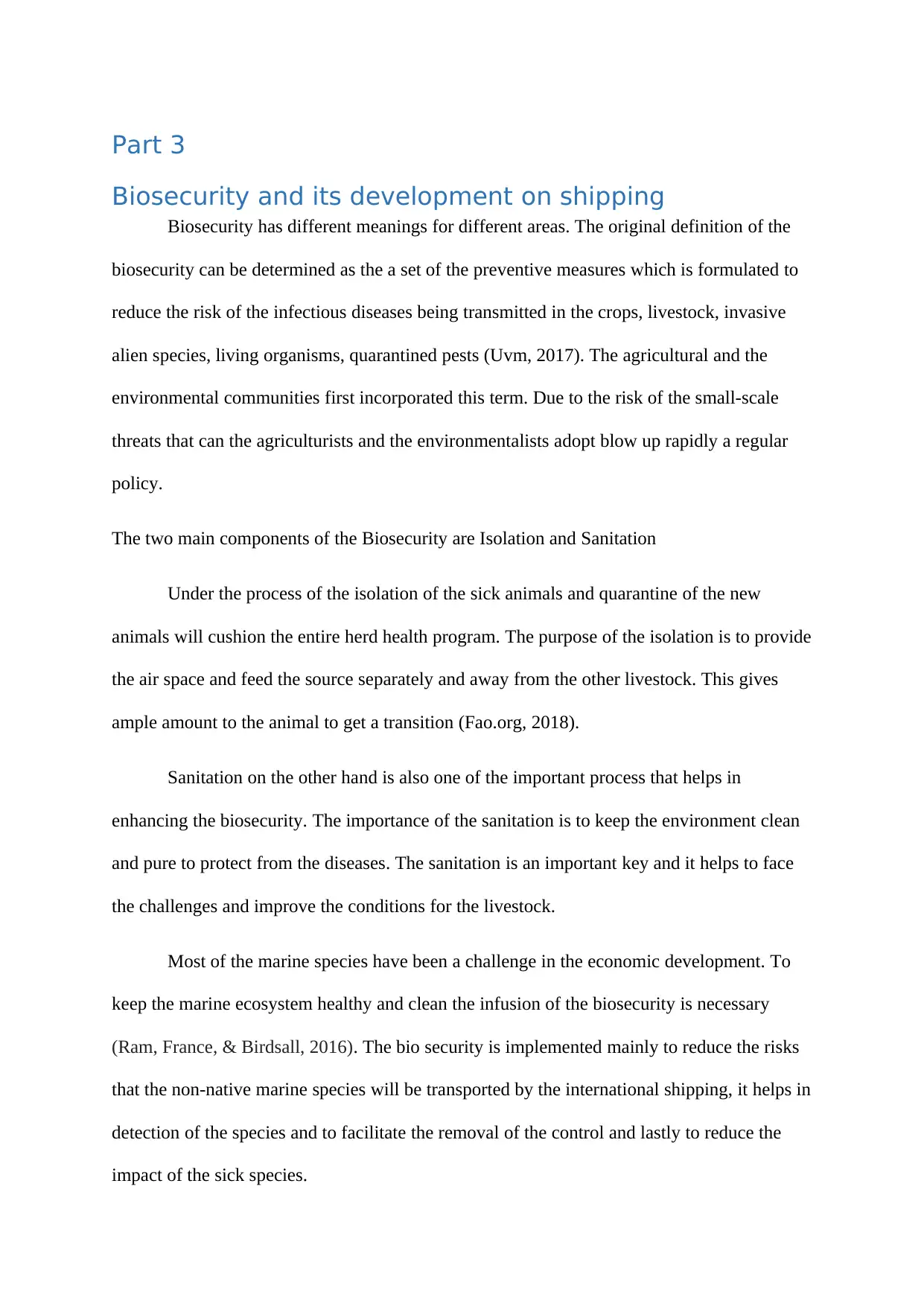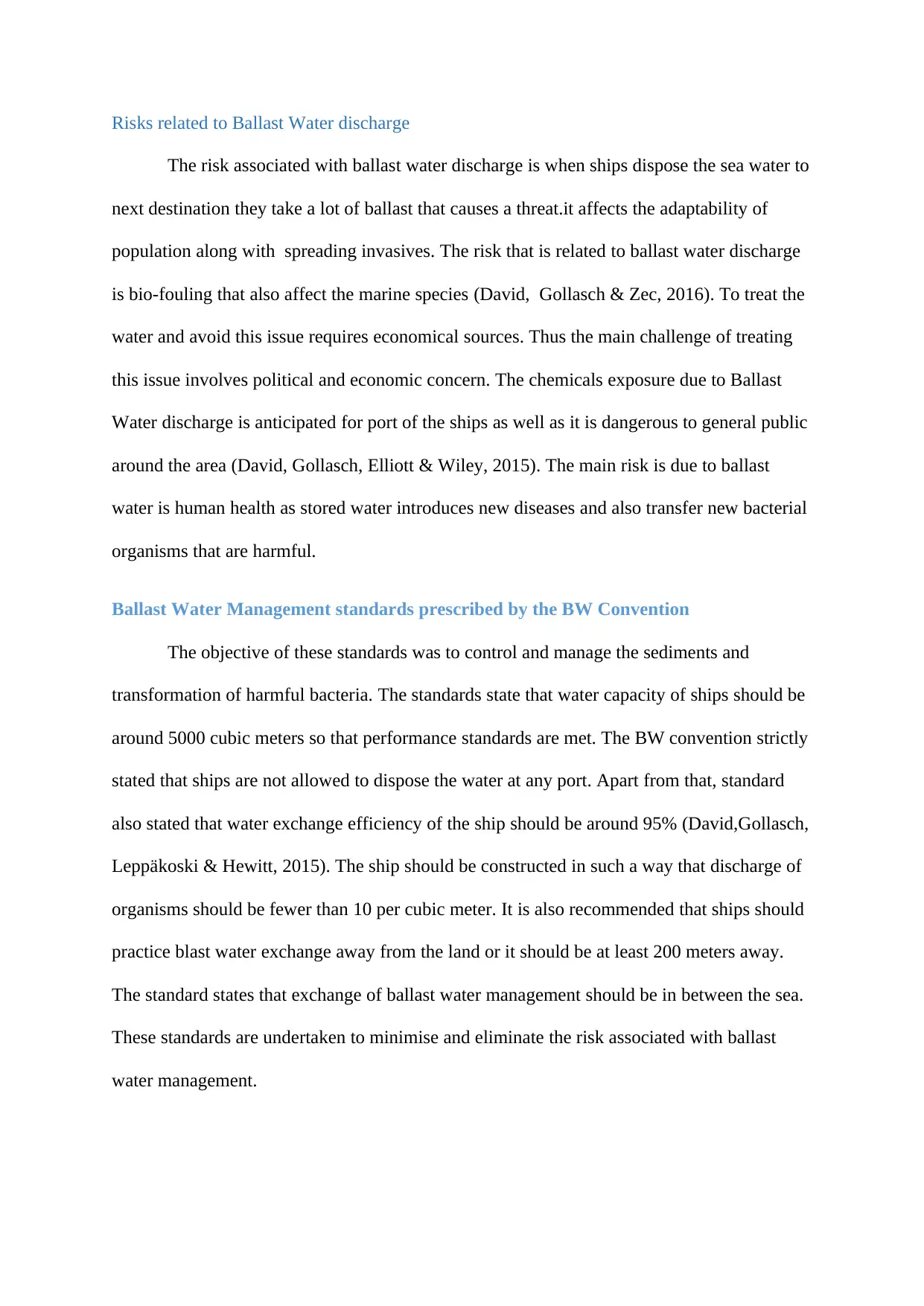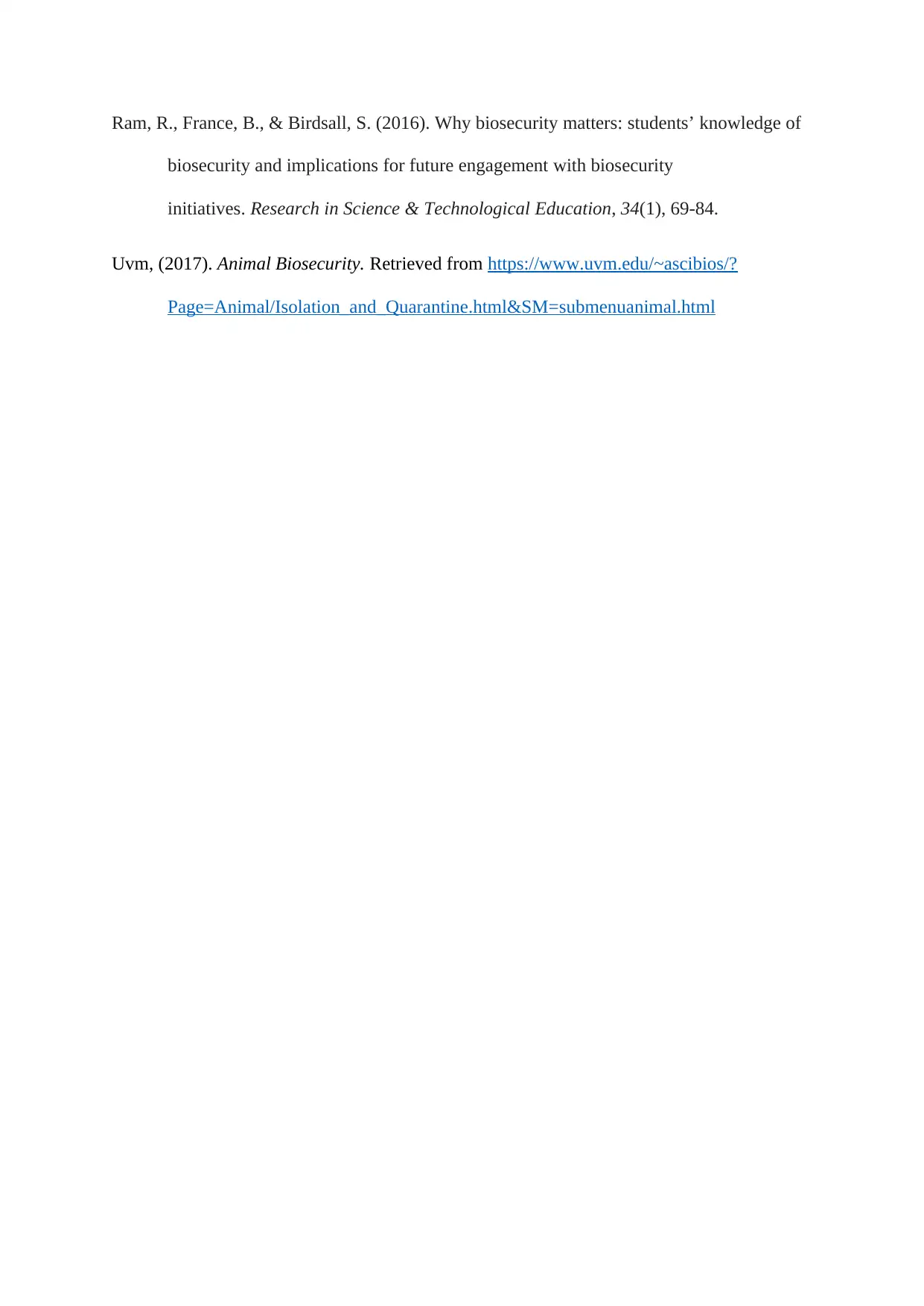Biosecurity and its development on shipping
VerifiedAdded on 2023/06/10
|5
|1349
|84
AI Summary
This article discusses the meaning of biosecurity and its two main components, isolation and sanitation. It then focuses on the importance of biosecurity in marine ecosystems and the risks associated with ballast water discharge. The article also explains the Ballast Water Management standards prescribed by the BW Convention and the main steps to manage oil spills on board ships.
Contribute Materials
Your contribution can guide someone’s learning journey. Share your
documents today.

Part 3
Biosecurity and its development on shipping
Biosecurity has different meanings for different areas. The original definition of the
biosecurity can be determined as the a set of the preventive measures which is formulated to
reduce the risk of the infectious diseases being transmitted in the crops, livestock, invasive
alien species, living organisms, quarantined pests (Uvm, 2017). The agricultural and the
environmental communities first incorporated this term. Due to the risk of the small-scale
threats that can the agriculturists and the environmentalists adopt blow up rapidly a regular
policy.
The two main components of the Biosecurity are Isolation and Sanitation
Under the process of the isolation of the sick animals and quarantine of the new
animals will cushion the entire herd health program. The purpose of the isolation is to provide
the air space and feed the source separately and away from the other livestock. This gives
ample amount to the animal to get a transition (Fao.org, 2018).
Sanitation on the other hand is also one of the important process that helps in
enhancing the biosecurity. The importance of the sanitation is to keep the environment clean
and pure to protect from the diseases. The sanitation is an important key and it helps to face
the challenges and improve the conditions for the livestock.
Most of the marine species have been a challenge in the economic development. To
keep the marine ecosystem healthy and clean the infusion of the biosecurity is necessary
(Ram, France, & Birdsall, 2016). The bio security is implemented mainly to reduce the risks
that the non-native marine species will be transported by the international shipping, it helps in
detection of the species and to facilitate the removal of the control and lastly to reduce the
impact of the sick species.
Biosecurity and its development on shipping
Biosecurity has different meanings for different areas. The original definition of the
biosecurity can be determined as the a set of the preventive measures which is formulated to
reduce the risk of the infectious diseases being transmitted in the crops, livestock, invasive
alien species, living organisms, quarantined pests (Uvm, 2017). The agricultural and the
environmental communities first incorporated this term. Due to the risk of the small-scale
threats that can the agriculturists and the environmentalists adopt blow up rapidly a regular
policy.
The two main components of the Biosecurity are Isolation and Sanitation
Under the process of the isolation of the sick animals and quarantine of the new
animals will cushion the entire herd health program. The purpose of the isolation is to provide
the air space and feed the source separately and away from the other livestock. This gives
ample amount to the animal to get a transition (Fao.org, 2018).
Sanitation on the other hand is also one of the important process that helps in
enhancing the biosecurity. The importance of the sanitation is to keep the environment clean
and pure to protect from the diseases. The sanitation is an important key and it helps to face
the challenges and improve the conditions for the livestock.
Most of the marine species have been a challenge in the economic development. To
keep the marine ecosystem healthy and clean the infusion of the biosecurity is necessary
(Ram, France, & Birdsall, 2016). The bio security is implemented mainly to reduce the risks
that the non-native marine species will be transported by the international shipping, it helps in
detection of the species and to facilitate the removal of the control and lastly to reduce the
impact of the sick species.
Secure Best Marks with AI Grader
Need help grading? Try our AI Grader for instant feedback on your assignments.

Risks related to Ballast Water discharge
The risk associated with ballast water discharge is when ships dispose the sea water to
next destination they take a lot of ballast that causes a threat.it affects the adaptability of
population along with spreading invasives. The risk that is related to ballast water discharge
is bio-fouling that also affect the marine species (David, Gollasch & Zec, 2016). To treat the
water and avoid this issue requires economical sources. Thus the main challenge of treating
this issue involves political and economic concern. The chemicals exposure due to Ballast
Water discharge is anticipated for port of the ships as well as it is dangerous to general public
around the area (David, Gollasch, Elliott & Wiley, 2015). The main risk is due to ballast
water is human health as stored water introduces new diseases and also transfer new bacterial
organisms that are harmful.
Ballast Water Management standards prescribed by the BW Convention
The objective of these standards was to control and manage the sediments and
transformation of harmful bacteria. The standards state that water capacity of ships should be
around 5000 cubic meters so that performance standards are met. The BW convention strictly
stated that ships are not allowed to dispose the water at any port. Apart from that, standard
also stated that water exchange efficiency of the ship should be around 95% (David,Gollasch,
Leppäkoski & Hewitt, 2015). The ship should be constructed in such a way that discharge of
organisms should be fewer than 10 per cubic meter. It is also recommended that ships should
practice blast water exchange away from the land or it should be at least 200 meters away.
The standard states that exchange of ballast water management should be in between the sea.
These standards are undertaken to minimise and eliminate the risk associated with ballast
water management.
The risk associated with ballast water discharge is when ships dispose the sea water to
next destination they take a lot of ballast that causes a threat.it affects the adaptability of
population along with spreading invasives. The risk that is related to ballast water discharge
is bio-fouling that also affect the marine species (David, Gollasch & Zec, 2016). To treat the
water and avoid this issue requires economical sources. Thus the main challenge of treating
this issue involves political and economic concern. The chemicals exposure due to Ballast
Water discharge is anticipated for port of the ships as well as it is dangerous to general public
around the area (David, Gollasch, Elliott & Wiley, 2015). The main risk is due to ballast
water is human health as stored water introduces new diseases and also transfer new bacterial
organisms that are harmful.
Ballast Water Management standards prescribed by the BW Convention
The objective of these standards was to control and manage the sediments and
transformation of harmful bacteria. The standards state that water capacity of ships should be
around 5000 cubic meters so that performance standards are met. The BW convention strictly
stated that ships are not allowed to dispose the water at any port. Apart from that, standard
also stated that water exchange efficiency of the ship should be around 95% (David,Gollasch,
Leppäkoski & Hewitt, 2015). The ship should be constructed in such a way that discharge of
organisms should be fewer than 10 per cubic meter. It is also recommended that ships should
practice blast water exchange away from the land or it should be at least 200 meters away.
The standard states that exchange of ballast water management should be in between the sea.
These standards are undertaken to minimise and eliminate the risk associated with ballast
water management.

Main steps to manage oil spills on board ships
The main steps that need to be followed at time of oil spills are, it is suggested
whenever oil spill is found on the surface of ship. The side scuppers are closed and the alarm
rings so that staff of the ship becomes aware about the oil spills (Akyuz & Celik, 2015). As
soon as oil spill is noticed all the transfers are stopped immediately and the effected tank is
found so that precautions could be taken (Banda,Goerlandt, Kuzmin, Kujala & Montewka,
2016). The emergency master need to be called so that is the duties regarding list of oil spill
is taken. Apart from that SOPEP drum is cleaned and effected area is cleared. The additional
barrier for this issue would be putting saw dust over the scupper plug so that oil does not
spread over the board (Akyuz, 2015).
The spill of oil can be controlled by the state authorities of ship by using oil
dispersant chemicals. The source of spill is found so that future leakage is controlled. The oil
spill is drained out in some empty area so that stress and stability of vessels are managed.
After the spill, to avoid the chances of reoccurrence corrective actions need to be taken
(Banda,Goerlandt, Kuzmin, Kujala & Montewka, 2016). The oil prevention team future
decides that intake of air should be stopped to avoid major reactions. The water is pumped
into the leaking tank so that it stopped future penetration of oil (Powell, 2017). Apart from
that, level of oil in the tanks is looked and reduces so that stability of vessels is maintained.
No chemicals should be used at time of oil spill as it can react and cause future issues.
The main steps that need to be followed at time of oil spills are, it is suggested
whenever oil spill is found on the surface of ship. The side scuppers are closed and the alarm
rings so that staff of the ship becomes aware about the oil spills (Akyuz & Celik, 2015). As
soon as oil spill is noticed all the transfers are stopped immediately and the effected tank is
found so that precautions could be taken (Banda,Goerlandt, Kuzmin, Kujala & Montewka,
2016). The emergency master need to be called so that is the duties regarding list of oil spill
is taken. Apart from that SOPEP drum is cleaned and effected area is cleared. The additional
barrier for this issue would be putting saw dust over the scupper plug so that oil does not
spread over the board (Akyuz, 2015).
The spill of oil can be controlled by the state authorities of ship by using oil
dispersant chemicals. The source of spill is found so that future leakage is controlled. The oil
spill is drained out in some empty area so that stress and stability of vessels are managed.
After the spill, to avoid the chances of reoccurrence corrective actions need to be taken
(Banda,Goerlandt, Kuzmin, Kujala & Montewka, 2016). The oil prevention team future
decides that intake of air should be stopped to avoid major reactions. The water is pumped
into the leaking tank so that it stopped future penetration of oil (Powell, 2017). Apart from
that, level of oil in the tanks is looked and reduces so that stability of vessels is maintained.
No chemicals should be used at time of oil spill as it can react and cause future issues.

References
Akyuz, E. (2015). Quantification of human error probability towards the gas inerting process
on-board crude oil tankers. Safety science, 80, 77-86.
Akyuz, E., & Celik, M. (2015). A methodological extension to human reliability analysis for
cargo tank cleaning operation on board chemical tanker ships. Safety Science, 75,
146-155.
Banda, O. A. V., Goerlandt, F., Kuzmin, V., Kujala, P., & Montewka, J. (2016). Risk
management model of winter navigation operations. Marine pollution bulletin, 108(1-
2), 242-262.
David, M., Gollasch, S., & Zec, D. (2016). Ballast water management system for Adriatic
Sea protection. IPA Adriatic Crossborder Cooperation Programme, pp. 67-90
David, M., Gollasch, S., Elliott, B., & Wiley, C. (2015). Ballast water management under the
ballast water management convention. In Global maritime transport and ballast water
management (pp. 89-108). Springer, Dordrecht.
David, M., Gollasch, S., Leppäkoski, E., & Hewitt, C. (2015). Risk assessment in ballast
water management. In Global Maritime Transport and Ballast Water
Management (pp. 133-169). Springer, Dordrecht.
Fao.org, (2018). Biosecurity principles and components. Retrieved froom
http://www.fao.org/tempref/docrep/fao/010/a1140e/a1140e01.pdf
Powell. W. (2017). Powell management. Retrieved from
https://www.tdi-bi.com/vessels/powell-cert/TDI%20Brooks%20-%20SOPEP%20-
%20J.W.%20POWELL%20-%20R.01.pdf.
Akyuz, E. (2015). Quantification of human error probability towards the gas inerting process
on-board crude oil tankers. Safety science, 80, 77-86.
Akyuz, E., & Celik, M. (2015). A methodological extension to human reliability analysis for
cargo tank cleaning operation on board chemical tanker ships. Safety Science, 75,
146-155.
Banda, O. A. V., Goerlandt, F., Kuzmin, V., Kujala, P., & Montewka, J. (2016). Risk
management model of winter navigation operations. Marine pollution bulletin, 108(1-
2), 242-262.
David, M., Gollasch, S., & Zec, D. (2016). Ballast water management system for Adriatic
Sea protection. IPA Adriatic Crossborder Cooperation Programme, pp. 67-90
David, M., Gollasch, S., Elliott, B., & Wiley, C. (2015). Ballast water management under the
ballast water management convention. In Global maritime transport and ballast water
management (pp. 89-108). Springer, Dordrecht.
David, M., Gollasch, S., Leppäkoski, E., & Hewitt, C. (2015). Risk assessment in ballast
water management. In Global Maritime Transport and Ballast Water
Management (pp. 133-169). Springer, Dordrecht.
Fao.org, (2018). Biosecurity principles and components. Retrieved froom
http://www.fao.org/tempref/docrep/fao/010/a1140e/a1140e01.pdf
Powell. W. (2017). Powell management. Retrieved from
https://www.tdi-bi.com/vessels/powell-cert/TDI%20Brooks%20-%20SOPEP%20-
%20J.W.%20POWELL%20-%20R.01.pdf.
Secure Best Marks with AI Grader
Need help grading? Try our AI Grader for instant feedback on your assignments.

Ram, R., France, B., & Birdsall, S. (2016). Why biosecurity matters: students’ knowledge of
biosecurity and implications for future engagement with biosecurity
initiatives. Research in Science & Technological Education, 34(1), 69-84.
Uvm, (2017). Animal Biosecurity. Retrieved from https://www.uvm.edu/~ascibios/?
Page=Animal/Isolation_and_Quarantine.html&SM=submenuanimal.html
biosecurity and implications for future engagement with biosecurity
initiatives. Research in Science & Technological Education, 34(1), 69-84.
Uvm, (2017). Animal Biosecurity. Retrieved from https://www.uvm.edu/~ascibios/?
Page=Animal/Isolation_and_Quarantine.html&SM=submenuanimal.html
1 out of 5
Your All-in-One AI-Powered Toolkit for Academic Success.
+13062052269
info@desklib.com
Available 24*7 on WhatsApp / Email
![[object Object]](/_next/static/media/star-bottom.7253800d.svg)
Unlock your academic potential
© 2024 | Zucol Services PVT LTD | All rights reserved.